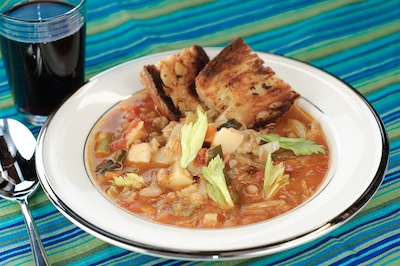By Michael Natkin ,
JTNews Columnist
Homemade minestrone has got to be one of the best rainy day foods in the world. Living in Seattle, we’ve got ample opportunity to test that theory. It is certainly miles beyond the canned version. Add a glass of wine and a couple of big garlicky croutons to soak up the broth, maybe a salad, and you have a whole meal.
The version of minestrone I always come back to is based on Marcella Hazan’s Minestrone alla Romagnola recipe in “Essentials of Classic Italian Cooking.” Marcella recently passed away after many years of touching hearts and tables around the world. I’ve just streamlined her recipe a bit (soaking zucchini? why?) and omitted the beef broth to make it vegetarian. I think you will find it equally delicious with the simple tomatoey broth, especially if you include the parmesan rind.
The what? That’s right, the parmesan rind. You know when you buy a piece of Parmigiano-Reggiano, there’s always that piece at the end that’s too hard to grate? Scrub those a bit and throw them in the freezer. Then, when you’re ready to make minestrone, toss it in the pot. While the soup simmers, all that incredible flavor extracts out, filling the soup with umami. (Of course you can omit this for a vegan version, or if you don’t eat cheese with animal rennet.)
You can toss this soup together and let it simmer for just an hour, and it will be good. But if you can let it simmer for two or three hours, the flavor will truly develop. Even better, make it a day ahead of time and reheat it. I haven’t been able to track down the science behind it, but umami-rich foods, and tomato-flavored foods in particular, always improve after 24 hours. If anyone has seen any research on this, please let me know.
As Marcella points out, this is one of those lovely dishes that doesn’t require perfect advance preparation. You can easily prepare and cut each vegetable as the previous one is added to the pot and sautéed.
Vegetarian Minestrone
Vegetarian; gluten-free if you omit the crouton; vegan if you omit the cheese
1/2 cup extra-virgin olive oil
1 medium onion, thinly sliced
1-2 medium carrots, small diced
3 stalks celery, small diced (reserve leaves for garnish)
2 cups small-diced waxy potatoes, skin on
1 handful green beans, ends trimmed, cut in 1/2″ lengths
3 medium zucchini, small diced
3 cups finely shredded cabbage (Savoy or green)
1-2 tablespoons vegetable broth powder; I like Seitenbacher (double check gluten free / vegan status if important to you). Don’t be tempted to use a thick vegetarian broth; you can use a pre-mixed one as long as it is a clear, brown type that tastes good.
1 parmesan rind (see above)
1 15-oz. can good-quality whole Italian tomatoes with juice
salt
1/2 cup grated Parmigiano-Reggiano
1 15-oz. can cannellini or white navy beans, drained and rinsed
Big garlic-butter croutons for serving (optional)
Heat the pot and the olive oil over a medium-low flame. Add the onion and a big pinch of salt and sauté for 3 minutes. Add each of the following ingredients in turn, tossing and allowing to cook for 2-3 minutes after each one: carrots, celery, potatoes, green beans, zucchini, cabbage. Cook for 5 more minutes.
Stir the broth powder into 6 cups of water and add to the pot. Add the parmesan rind. Add the tomatoes and their juice, and break them up a bit. Taste and add a little salt, with caution.
Cover the pot and reduce the heat to a low simmer. Cook for at least another 30 minutes and preferably up to 2-1/2 hours.
Uncover, add the cannelini, and simmer for another 15-30 minutes. If it gets too thick, add a bit more broth or water. If it’s too thin, raise the heat just a little — don’t boil hard or the vegetables will break up.
To serve, discard the parmesan rind and stir in the grated cheese; taste and salt as needed. Ladle into soup bowls, garnish with the reserved celery leaves and a couple of the garlic-butter croutons. Pass more grated parmesan at the table. You might also like a little additional drizzle of good olive oil.
Serves 6-8 as a main course.
Local food writer and chef Michael Natkin’s 2012 cookbook “Herbivoracious, A Flavor Revolution with 150 Vibrant and Original Vegetarian Recipes,” was a finalist this year for a James Beard award. The recipes are based on his food blog, herbivoracious.com.
